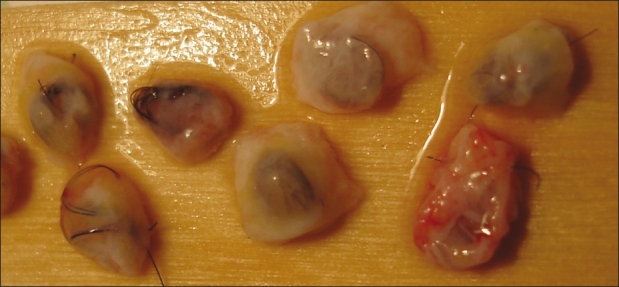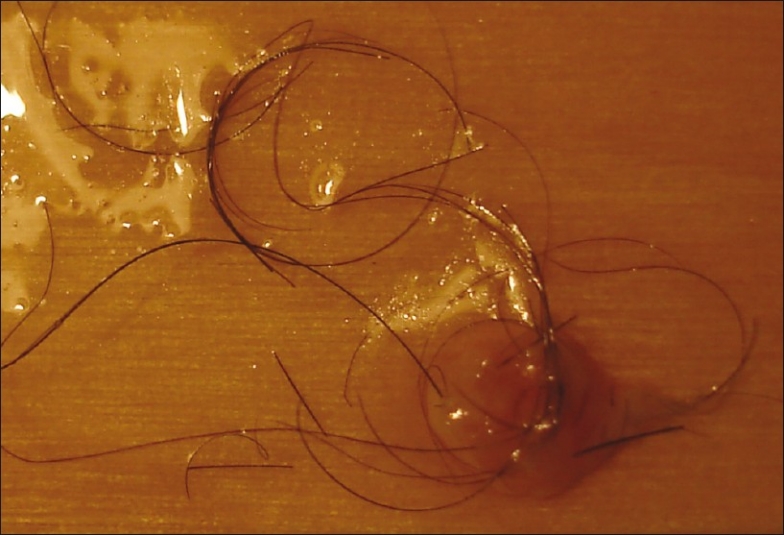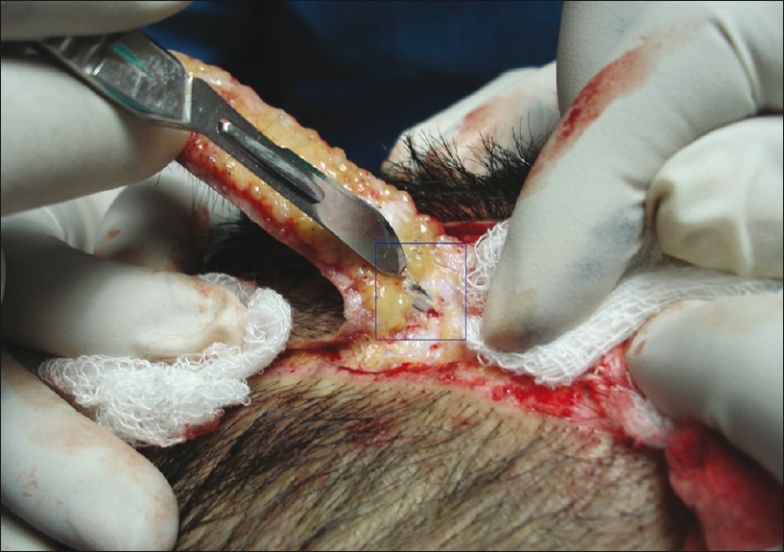Abstract
Follicular unit extraction (FUE) is an accepted method of extracting individual follicular unit grafts for hair transplant surgery. Since follicles are harvested from the back of the scalp using tiny punches resulting in minimal scarring, it has gained rapid acceptance among the patients. However, due care needs to be exercised while performing FUE. FUE should not be confused with the older plug graft extraction methods of coring out hair-bearing skin plugs. Lack of due diligence while performing such extractions can lead to subluxation of the grafts into the subdermal layer of scalp. Overtumescence of the scalp donor area, use of blunt punches and trying to “core” out the full thickness grafts can all contribute to this. The following cases illustrate some pitfalls to be avoided while performing FUE and the adverse consequences if they occur.
Keywords: Follicular unit extraction, tumescence, androgenic alopecia, follicular unit graft
Introduction
Follicular unit extraction (FUE)[1] is an accepted method in hair restoration surgery for the treatment of male pattern baldness/androgenic alopecia.[2] In FUE, individual follicular unit grafts are extracted using tiny punches. The punches (of 1 mm or less in diameter) are used to score around the follicular unit till the middermis level. Gentle traction is applied to the graft thus scored. The extracted grafts are then trimmed and placed in the recipient slits created in the bald or balding scalp.
Since the extraction sites/holes are very small (1 mm or less), no suturing is required.
The wounds heal by secondary intention.
Case Report
Three patients in the age group of 25–30 years approached us for hair transplant repair surgery. All of these normotensive, nondiabetic males had undergone hair transplant surgery at some other clinic, supposedly, by the FUE technique. The common complaints were multiple, slow growing nodular, painless swellings in the scalp donor area. The patients had approached us 6 months to 2 years after their previous “FUE” hair transplant.
Investigations
All routine investigations were within normal limits. Gross examination of the scalp donor area revealed nontender, nodular swellings with no signs of inflammation or ingrown hair.
Surgery
Under aseptic precautions and after the local anesthetic administration, a strip was extracted from the donor area of the scalp. During strip excision, multiple cysts were seen in the subdermal fatty layer of scalp [Figures 1–3].[3] Gross examination of the cysts revealed long hair, intact hair bulbs as well as skin tissue, suggestive of full thickness follicular unit grafts [Figures 4 and 5].
Figure 1.

The yellow arrow point to the subdermal cyst
Figure 3.

Intraoperative picture of strip excision showing the subdermal cyst
Figure 4.

Excised subdermal cysts
Figure 5.

Dissected cyst
Figure 2.

Intraoperative picture showing subdermal cyst
These cysts were excised individually and sent for histopathological examination. The strip donor area was cleaned of all caseous material, hair, etc., and then sutured.
HPE report: Gross – showed multiple yellowish fatty to light brown soft tissue bits together measuring 1.8 × 1.3 × 0.5 cm.
Impression:[1] Dense chronic folliculitis with scattered eosinophils and stromal fibrosis.[2] No granulomas and atypia were noted.
Summary
The possible reason for the formation of cystic masses subdermally is the subluxation of full thickness scalp grafts below the surrounding dermis which was then left in situ. The surrounding scalp tissue healed by secondary intention, thus, burying the full thickness grafts in the subdermal layer.
Discussion
FUE should not be confused with the older punch graft excision methods. In the older methods, a 3–4 mm punch was used to cut around the hair bearing scalp tissue, down to the subdermal tissue. This was followed by extracting the hair plug like an excision biopsy.
FUE, however, uses much smaller diameter punches (1 mm or less). The punch is not to be used in a “coring” manner and is supposed to be used to score around the individual follicular unit only till the middermis level. In this manner, the follicular unit graft still remains attached to the reticular dermis.
The cases presented in this report highlight the pitfalls/drawback if these tenets of performing FUE are not followed.
Possible contributing factors for the formation of subdermal cysts in the above cases could be as follows:
Lack of due diligence on part of the extractor who failed to locate and extract all punched grafts.
Over tumescence of the scalp donor tissue: Excess use of the tumescing fluid leads to a ballooning of the subdermal layer. When the subdermal layer expands to the thickness of the entire dermis, it is easy for the “cored” and detached graft to slip below the surrounding dermis.
Use of blunt punches leading to subluxation of grafts in the subdermis along the surrounding tissue. Using blunt punches requires more force to be exerted in the vertical direction for cutting. This reduces the tactile sensitivity of the extractor and contributes to cutting to deeper layers of the dermis. The punches used for scoring around the follicular unit graft must be very sharp.
Deep coring through the entire depth of the reticular dermis should be avoided. The punch must be used to score around the follicular unit graft till the reticular dermis. Since, the reticular dermis is denser than the overlying papillary dermis, the extractor will feel increased resistance when he/she reaches that layer. Scoring should not be carried beyond that point. The attachment to the reticular dermis will ensure that the graft does not “sink” and remains in position till extracted.
Conclusion
FUE is a refined extraction technique that, while being minimally invasive and stitchless, needs to be mastered and performed meticulously. FUE should not be considered a variant of the older punch graft excision methods. Meticulous dissection, use of sharp punches only, and avoiding overtumescence will help avoid inadvertent subluxation of follicular unit grafts below the dermis.
Footnotes
Source of Support: Nil
Conflict of Interest: Nil.
References
- 1.Rassman W. Follicular Unit Extraction: Minimally Invasive Surgery for Hair Transplantation. Dermatologic Surgery. 2002;28:720–8. doi: 10.1046/j.1524-4725.2002.01320.x. [DOI] [PubMed] [Google Scholar]
- 2.Tokyo: Springer-Verlag; 1996. Inaba. Masumi Androgenetic Alopecia. Modern Concepts of Pathogenesis and Treatment; pp. 238–45. [Google Scholar]
- 3.Epstein WL, Kligman AM. Epithelial cysts in buried human skin. AMA Arch Derm. 1957;76:437. doi: 10.1001/archderm.1957.01550220045009. [DOI] [PubMed] [Google Scholar]


